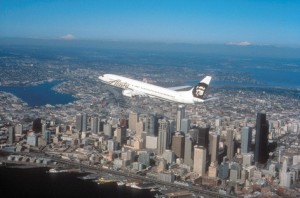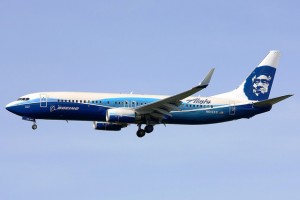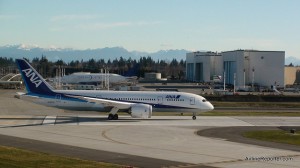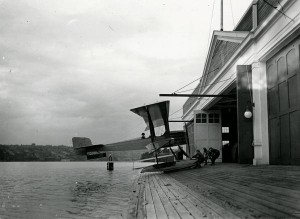
Alaska Airlines flying over Seattle
What are you up to this Monday from 2pm to 6pm? Well if you are in the area of Seattle-Tacoma International Airport, come check out Alaska Airline’s Board Room…there will be a special culinary event going on.
This week, I am actually visiting their Board Room twice. The first on Monday to see how one of these special events goes and then on Thursday to get my hands dirty and actually work for a bit in a Boardroom and share what that experience is like. I am embarrassed to admit this, but I haven’t had a lot of experience in airline board rooms and want to learn a little bit more what they are all about.
The event on Monday is free for Board Room members or you can purchase a day pass for only $40. There will be good food and wine for you to sample. If you can make it, be sure to let me know so we can chat!
To learn more, check out their website.

Alaska Airlines 737-800 with special Boeing livery (N512AS)
Alaska Airlines, Boeing, Portland International Airport, Seattle-Tacoma International Airport, Spokane International Airport and Washington State University are working together to promote aviation biofuel development in the Pacific Northwest. The regional assessment is called the Sustainable Aviation Fuels Northwest (SAFN).
The group hopes to examine all phases of developing an aviation biofuel industry and the funding is being split between the involved parties. SAFN will be looking at local biomass sources that can be found in the Pacific Northwest.
“By transitioning to a more fuel-efficient fleet and adopting technology to follow more direct flight paths, Alaska Airlines has made significant strides in minimizing the environmental impact of our flying in the communities we serve,” said Alaska Air Group Chairman and CEO Bill Ayer. “Through this initiative, we are joining other key stakeholders in our region to explore the development of alternatives to jet fuel that could further reduce our carbon footprint.”
The project is starting this month and is expected to take about six months. Air travel currently generates approximately 2 percent of man-made carbon emissions, and the industry has set aggressive goals to lower its carbon footprint, which includes the use of aviation biofuel when it becomes available.
This is only one of several regional biofuel projects that Boeing is currently working with. Curious to find out what Boeing hopes to achieve in this project, I spoke with Terrance Scott, who is with Boeing Environmental Communications. He explained there are four ways to help airlines curb their carbon emissions. The first is product development, where Boeing creates new, more fuel efficient aircraft, like the Boeing 787 and the Boeing 747-8. The second is to retrofit currently flying aircraft with performance packages, winglets and other items. Third is to change the way airlines fly and operate aircraft in order to be more efficient. The last way is the type of fuel used to power the aircraft.
Boeing has helped or will be helping to set up similar regional groups in the Middle East, China, Australia and Mexico. The hope is to create a regional portfolio of fuel sources to create aviation biofuel. Scott told me that Boeing wants to motivate people to find answers, but is not looking to get into the biofuels business themselves. “Boeing doesn’t want to get into the fuel business, but we want to serve as a catalyst.” Their plan is to bring people together, to start talking and working on creating sources for biofuel.
The use of biofuels have already been successfully tested. Boeing has worked with Air New Zealand and Continental to show airlines can successfully use biofuels. Now that biofuel has been proven to be a good alternative to legacy jet fuel, the shift is being made to find a sustainable, economically feasible fuel source. They want to make sure that a fuel source won’t compete with any food source (ie corn and E85).
Most likely any biofuel will cost more than jetfuel today. Would passengers be willing to pay a little bit more to fly green? I think there are some that would, but I am not sure if there would be enough.
http://safug.org/
Image: Axel J

ANA Boeing 777-300ER (JA777A)
I love a good beer. At home, canned or bottled beer does alright, but when I am out I always get draft. Sometimes when I fly, I might have a beer and will make do it coming out of a can or bottle. However, All Nippon Airways (ANA) is taking it up a notch by providing draft beer on some of their flights.
Draft beer you would find at your local pub comes out of a keg, using highly pressurized carbon dioxide gas, which can’t be brought on board a plane. However, ANA worked with Hoshizaki Electric and successfully developed a beer dispenser made especially for in-flight use. Dry ice is used to keep the beer cold (and refreshing) during the flight.
Starting July 20th, passengers on domestic ANA flights will have the opportunity to try some draft beer. Let’s hope this catches on and more airlines will soon follow suit.
Image: Tom Turner

Photo of Boeing 787 Dreamliner ZA002 with ANA livery taken at Paine Field during its first flight.
Boeing announced today that they hope to still deliver the first Boeing 787 Dreamliner to All Nippon Airways by the end of the year, but the delivery could be pushed into early 2011. Boeing points to issues with instrumentation configuration and problems with the horizontal stabilizer as reason for the possible delay.
“We have seen some test instrumentation configuration changes that have taken a bit longer than we had planned,” Scott Fancher, vice president and general manager of the Boeing 787 program said in a call with reporters. “That coupled with some of the inspection work that we’ve seen recently has led to a little bit of schedule pressure.”
It is unfortunate that this announcement will have a lot of people complaining about the Boeing 787 being delayed again. We must all remember, this is the next generation of aircraft and it is extremely complex. Boeing used companies all over the globe to build this plane and it is important to make sure the aircraft is 100% ready before being delivered to airlines. If that takes a little bit longer, I am alright with that. I rather the 787 Dreamliner be delayed a bit more than it pre-maturely gets delivered before it is ready.
Years from now, no one will remember how delayed the plane was…they will only remember how it ushered in a new era of air transport.

The first Boeing plane at their first assembly building, on Seattle's Lake Union. Picture from Boeing.
94 years ago today, the Pacific Aero Products Co was founded by William E Boeing in Seattle, WA and it has been an amazing ride since! Some key moments in their history:
1917: The company was renamed to the Boeing Airplane Company.
1927: Boeing started their own airline called Boeing Air Transport.
1933: Due to new regulations, Boeing was split into three companies: United Airlines, United Aircraft Corporation and the Boeing Airplane Company. This is the year that William Boeing also left Boeing.
1938: The first flight of the Boeing 314 Clipper.
1944: Due to the war over 350 aircraft were being built each month.
1957: The Boeing 707 has its first flight.
1960: Boeing purchased Vertol Aircraft Company which got them into the business of helicopters.
1963: The amazing Boeing 727 takes off for the first time.
1967: Just four years after the 727 has its first flight, the Boeing 737 takes to the sky.
1969: The first wide-bodied airliner, the Boeing 747, has its first flight and changes airline transportation forever.
1971: Funding for the Boeing 2707, the supersonic airliner, was cut.
1981: The first wide-bodied, twinjet airliner, the Boeing 767 has its first flight.
1982: The Boeing 757 has its first flight.
1994: The Boeing 777 successfully has its first flight.
1996: Boeing merges with McDonnell Douglas.
1998: The Boeing 717, which started life as the MD-95, has its first flight.
2001: Boeing moved its corporate headquarters from Seattle to Chicago.
2009: The much anticipated Boeing 787 Dreamliner has its first flight.
To read more about Boeing’s history, be sure to check out their huge history section on their website.




